Propulsions II
1/178
There's no tags or description
Looks like no tags are added yet.
Name | Mastery | Learn | Test | Matching | Spaced |
|---|
No study sessions yet.
179 Terms
What is the source for lubricants
Petroleum
What does the process for lubricants begin with
Crude petroleum
Crude is pulled out of the ground and is put in a chamber. It turns into a gas and when it cools below its boiling point heavy stuff at the bottom and light stuff at the top. It is then separated into gasoline, jet fuel, heating oil, lubricating oil
Lubricant definition
Substance with greasy properties used to reduce friction, prevent rust and corrosion on metalica surfaces
How are lubricants classified
Animal, Mineral, Vegetable, and Synthetic
Animal lubricants
Doesn’t produce a lot of heat, highly stable at normal temps
Produces fatty acids at high temps - not good for internal combustion engine
Vegetable lubricants
Not used because they wear away steel by loosening the bonds of iron on the surface (oxidizes when exposed to air)
Has a lower coefficient of friction than most mineral oils
Mineral lubricants
Used on most aircraft engines, chemically stable at high temps
Perform well at low temps
Classified as solid, semisolid, and fluid
Solid Mineral Lubricants
Don’t dissipate heat rapidly enough for high speed machines
Used in a powdered form (talc and graphite)
Semisolid Mineral Lubricants
Very heavy oils (grease)
Not good for continuous operation because the mix varies in consistency
Fluid Mineral Lubricants (oils)
Principle lubricants used in internal combustion engines because they can be pumped and sprayed easily
Fluids
Absorb and dissipate heat quickly
Provides good cushioning
Animal and Vegetable lubricants
Unstable at high temps
Perform poorly at low temps
Mineral Based lubricants
Stable at moderately high temps
Perform well at low temps
Used for reciprocating engines
Synthetic Lubricant
Developed because of the high temperature in aircraft engines
Not made from natural crude oil or are highly modified
Used in turbine engines
Do not evaporate easily, do not break down easily, do not produce coke or other deposits
Lubricating Oil properties
Flash point
Viscosity
Pour Points
Chemical stability
Flashpoint
Temperature at which the oil gets to a point where enough vapor comes off of it that it can ignite
Quick burn
Aircraft oils must have a high flash point because they operate at high temp
Engine operating temperature determines what
Type of oil grade to use
Fire point
Temperature enough vapor coming off the oil oil boiling enough vapor that a CONTINUOUS FLAME can occur over the oil
CONTINUOUS FLAME fiyuhhhh
50-60*F higher than the flashpoint
If used aircraft oil is tested and has a low flash point this means
There is dilluted fuel in the oil
A low fire point means
There is a lot of fuel in the oil
Viscosity
Fluid friction of the oil
High viscosity means its thick
Low viscosity means its thin
The flow of oil is referenced to its
Pour point which indicates the fluidity of oil at low temperatures
Pour point (the pee pee)
Lowest temperatures at which the oil will flow
Why is it important that oil be moving freely
So that the engine will start and can be pumped under colder conditions
Low viscosity oils - colder weather - (thinner)
Higher viscosity oils - warmer weather (thicker)
What is the goal with oil?
Use the lowest viscosity for operating at high temperatures
This ensures a thin film over all moving parts
Oil dilution
Fuel is added to the oil to circulate more readily in cold conditions
Disadvantages out weight advantages so now multigrade oil is used
(Oil dilution) What happens when the aircraft reaches normal operating temps
The fuel is burned off and the oil returns to original characteristics
Chemical stability is starbility against
oxidation (rusting), thermal crackng, and coking (solid product waste), must resist becoming emulsified (mixed with water)
Oil oxidizes at which temps
High
Oil should have
Minimum coefficient of friction
Maximum adhesion to the lubricated surfaces
Good oiliness characteristics
Adequate film strength
Why is lubrication needed
To reduce wear
To reduce power loss of engine from friction
3 types of friction
Sliding- surfaces sliding over eachother
Rolling- surfaces rolling over each other
Wiping- continually changing load on a contacting surface (between gear teeth)
4 factors needed for lubrication
Movement of 2 surfaces on one another
Condition and material of surfaces
Nature of contact movement
Load carried by surfaces
Oil is used not only for lubrication but also
In hydraulic systems,
To lubricate moving parts outside of the engine (prop reduction gear)
6 specific functions of engine oil
Reduce friction (lubricates)
Cools things (coolant)
Seals combustion chambers (sealant)
Cleans engine (cleanser)
Prevents corrosion (protector)
Acts as a cushion (buffer)
Straight mineral oil
Used primarily for break in period for most 4 cycle aviation engines,
Only has one additive
Ashless dispersant oil
Has dispersants that suspend contaminants
“Ashless” comes from additives that leave no ash when burned
Using this means less oil is consumed- Tends to stay cleaner
Grade of oil
Measured by an oils viscosity
Grade to be used in engine is determined by- operating temp and operating speeds
Single grade
industry standard
Flows slowly in colder weather (excessive wear and damage, poor lubrication- too thick)
Reacts poorly to temp change (too hot- gets too thin, too cold- gets too thick)
Multi viscosity oils
Used when needed for quick and easy flow at low temps
Also called multigrade oils
What is the purpose of a lubrication system?
Supply oil to the engine at the correct pressure and volume to provide adequate lubrication and cooling for all parts of the engine subject to friction
What is needed from each part of the lubrication system?
Oil tank - Must have adequate capacity
Oil pump - Volume and pressure must be good
Oil cooler - Oil must be cooled properly
What are the three different types of lubrication systems used on aircraft
Pressure lubrication system - Most aircraft use this or a combination of it and splaish/spray
Splash lubrication system
Spray lubrication system
Describe the pressure lubrication system (before manifold)
A mechanical pump is used to supply oil under pressure
Oil flows into the inlet side of the pump from the oil sump
The inlet is high enough on the sump so no sediment is drawn in
The pump forces oil into a manifold
Describe the pressure lubrication system (after manifold)
The oil manifold distributes to the crankshaft bearings
Oil flows from the crankshaft main bearings through to the connecting rod bearings
Oil for the camshaft comes straight from the oil manifold and flows out through the camshaft to the bearings and cams
Engine cylinder surfaces and piston pins are lubricated via a spray system
What are the components of lubrication systems?
Pressure oil pump, oil pressure relief valve, oil reservoir, oil pressure gauge, oil temperature gage, oil filter, piping and connections, oil cooler
Pressure oil pump
Either gear type or vane type
The pump can deliver more oil to the engine then required. This is so as the engine wear down there are greater clearances and more oil can fill those gaps
Replace the pump when oil pressure is not achieved within 30sec of engine startup
Oil pressure relief valve
Control and limit the lubricating oil pressure
Design consists of an oil pressure relief valve that is a plunger and spring
Oil reservoir
Must be enough oil to supply the engine at max operating temperature
Heating the engine thins out the oil so you need more
Oil supply is broken into usable and unusable oil
Oil pressure and temp gage
Pressure gage - Located where the oil enters the crankcase
Temp gage - Located in the oil inlet line or passage between the pressure pump and engine system
What type of oil filter system do most aircraft have?
Full flow type oil system - All of the oil is filtered
Partial flow type oil system - Only 10% of the oil filtered, this is on older aircraft
Filters may be simple screens which may or may not be disposable
What is the best place to to inspect for internal engine wear
Oil filter
Oil lines
Orange on the outside is a fire sleeve that protects the oil on the inside from excess heat
Subject to vibration- flexible lines
Little vibration- rigid lines
Oil cooler
Forces oil to follow through passages back and forth in cooler which have ram air passing through the.
Oil is going up and down in a S shape while the air is going in between the S
Open and closes based on oil temp
Wet sump system
Gravity returns it back for you
Not for aerobatic flight
Sprays against the back of the pistons and then goes down to the reservoir by gravity
Dry sump system
Supply line in the resivor in the bottom gets pumped up to the rest of the engine
Flexible weighted internal hose can still pump even in inverted flight
Return line takes the rest of that oil through a cooler back to the reservoir
Complete induction system
Three sections
Air scoop and duct leading to carburetor
Carburetor or air control section
Intake manifold and pipes
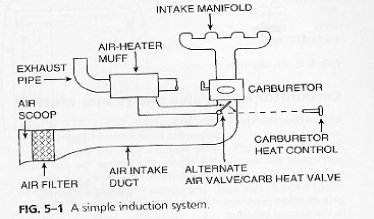
Air scoop and ducting section has 4 parts
Air scoop
Air filter
Alternate air valve
Carburetor heat air valve or heater muff
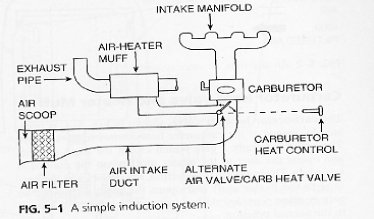
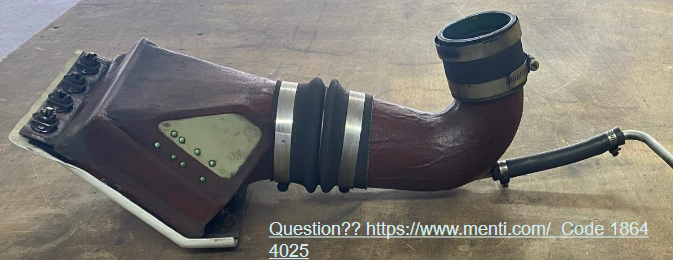
Air scoop
Opening facing airstream
Scoop receives ram air- usually augmented by the prop slipstream
Compression adds to the total weight of air received making it supercharged
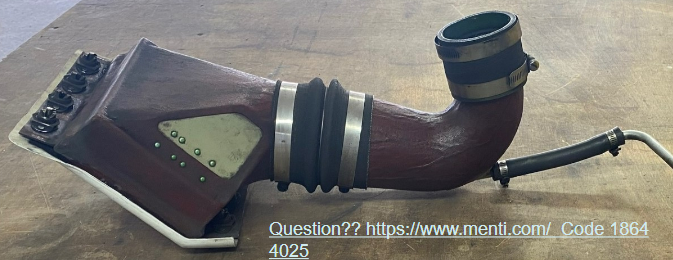
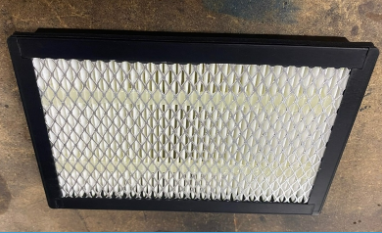
Air filter
Installed at or near air scoop
Remove dirt, sand and abrasive particles before going into the engine
Reduce air pressure somewhat because they slow down the air
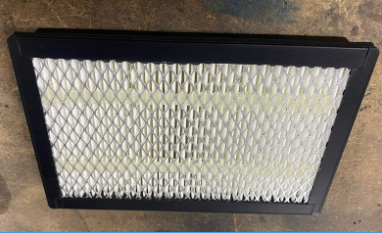
How any types of air filters are there
3
Foam soaked with oil
Paper - at 500 hours replace the filter because people were keeping them until they had massive holes
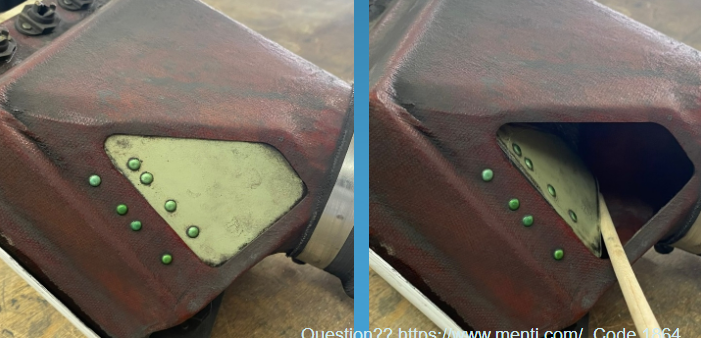
Alternate air valve
Allows air to get to the engine if filter or other parts become clogged
Either unfiltered warm from the engine or outside cold air
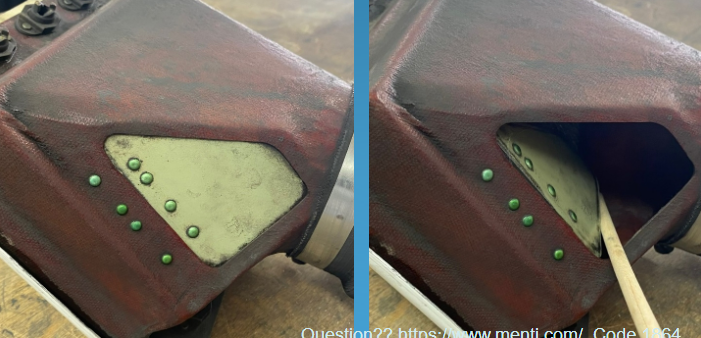
What are the functions of the alternate air valve
Counter carb ice
Use in heavy rain situations
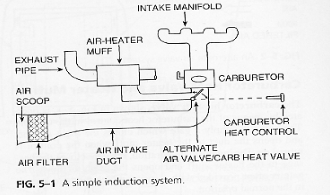
Carburetor heat air valve and heater muff
Operated from cockpit
Heater muff is a shroud placed around exhaust pipe
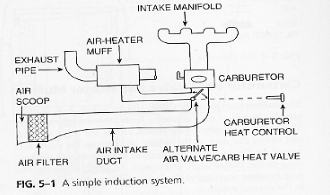
Prolonged use of carb heat causes what
Prolonged use of carburetor heat may also cause detonation especially at high power settings

Intake manifolds
Sends the pressurized fuel-air mixture into cylinders
One pipe per cylinder
Sometimes the intake manifold piping will extend to the oil sump which cools the oil slightly and to increase the temperature of the charge for better vaporization of fuel
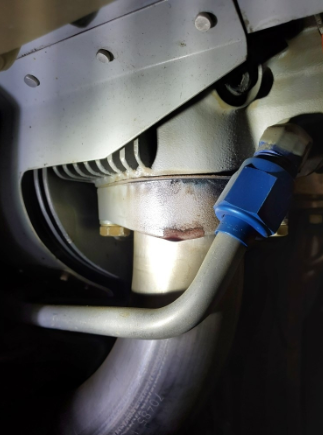
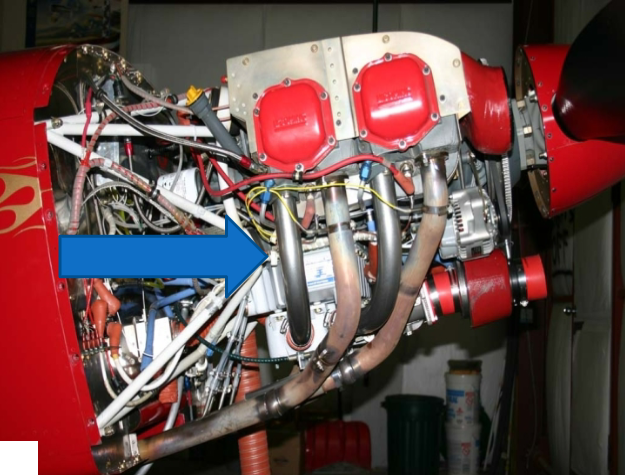
Downdraft and updraft induction
Updraft induction - Air goes from the bottom to the cylinder
Downdraft induction - Air goes from the top down to the cylinder
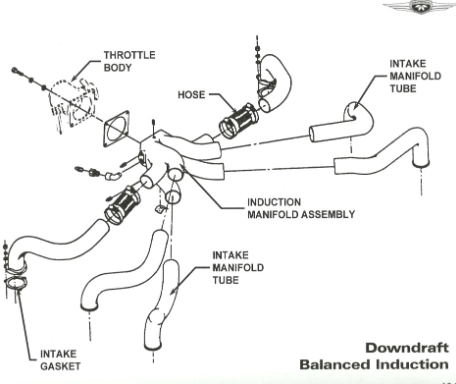
Manifold absolute pressure
Is below atmospheric in unsupercharged engines
Induction system icing
Can cut off flow of the fuel-air ratio
Three types of induction system icing:
Impact ice
Fuel evaporation ice
Throttle ice
Supercharger
A supercharger is an air compressor used to force more air into the combustion chamber of an internal combustion engine that can be achieved with standard atmospheric pressure
Considered supercharged when MAP is over 30Hg
Superchargers consist of
A centrifugal compressor connected to the air intake
Compressor can be driven by gearing from crankshaft and exhaust gasses (turbine)
What is a turbocharger
A supercharger that is turbine driven
What is the difference between a turbine and an impeller
Turbine- rotating device that is turned by an outside force such as air or water flowing past it to transform energy into power or to drive a compressor
Impeller- A rotating device used to force air or water in a desired direction under pressure can be the main rotor of a radial compressor which increases the velocity of the air being pumped
Engine normalizer
Raise the pressure in an engine but not above 30 Hg to compensate for the decreased air density
Capacity of supercharger depends on
Size of impeller
The speed its rotating
Manifold absolute pressure
Pressure in the intake manifold of an engine
In a normally aspirated engine MAP is less than atmospheric pressure due to friction loss within induction system
At what altitude can you use a supercharger with an engine with a high compression ratio
5000 or higher or else you fuckin die (detonation or preignition)
What does higher octane fuel allow for
Greater super charging (common fucking sense) (u cant put 100LL in a damn 737)
What is the purpose of supercharging
To increase the MAP above atmospheric pressure
Increasing MAP increases power output in 2 ways
Increases weight of charge delivered to engine cylinders
Increases compression pressure
What is the difference between a internal and external supercharger
The difference is where the supercharger is located in the engine system
EXTERNAL (turbocharger) - JESS WAKE THE FUCK UP ITS BEFORE THE CARB. The dense air wants to take more fuel, receives its power from the engine exhaust
Internal - After the carburetor
Turbo vs Turbosupercharger
If the air only compresses only to 30Hg then its called a turbocharger, if higher than 30Hg than its a turbosupercharger
Waste gate
Where exhaust gases are diverted to the turbochargers
The degree to which is open determines the degree of turbocharging
Turbochargers can deliver excess power up until
Their critical altitude
After critical altitude the charger will no longer deliver full power for which it was designed
Turbocharger limitations
Max and min engine RPM
Max MAP
Max Cylinder head temp
Range for carb inlet air temp
Turbocharger lubrication is accomplished at
Lower pressure than standard for an engine
whats the upper deck pressure of these zyns in my mouth
100
Deck pressure
Pressure between the discharge of the compressor and engine throttle valve
Maintains 28-30 Hg in a normalized engine or higher for boosted engine
Manifold pressure
Pressure after the throttle valve
What does a density controller do
Limits MAX MAP to prevent over boost and limiting deck pressure when aircraft is below engines critical altitude
Differential pressure controller
Regulates the waste gate position maintains preset differential across throttle usually 2-3 in
Variable pressure controller
Takes place of density and differential pressure controllers and controls both max MAP and regulates the differential
Often has a cam follower to preset for throttle setting
Over-boost control valve
Spring operated valve in the intake that opens when pressure gets too high
Overboost
When MAP exceeds the limits at which the engine was tested and certified by the FAA
Overshoot
Occurs when the automatic controls do not respond quickly enough to stop the inertia of the turbocharger speed increase with a rapid throttle increase (use small throttle movements)
Bootstrapping
Could be from a sticky or stuck waste gate
Basically because its sticky the controller sends too much oil pressure and then when there’s too much it sends less basically chasing its tail because the waste gate is stuck
What is turbine inlet temperature TIT?
Measurement of the EGT at the turbocharger turbine inlet
Why is excessive heat harmful in a reciprocating engine
Overheating - Fuel/air mixture is too hot, and you won’t get as good combustion, preignition or detonation may occur
Weakens and shortens the life of the engine - Parts may also warp and the engine may seize
Impairs lubrication - The viscosity of the oil is reduced
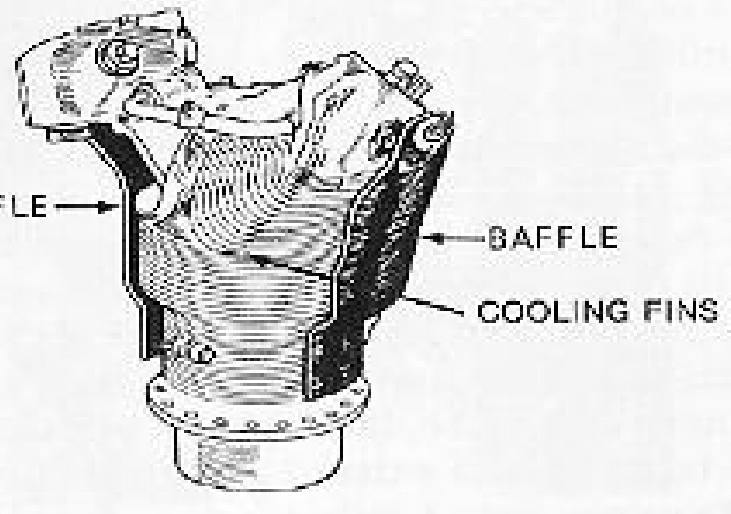
How is cooling achieved in an air-cooled engine?
Engines that are air cooled use thin fins that extend from the cylinder wall/head, as air flows over the fins excess heat is absorbed via conduction
Some cylinders use deflector baffles which are used to direct the flow of air for max cooling
Proper installation of the baffles is essential otherwise hot spots will occur
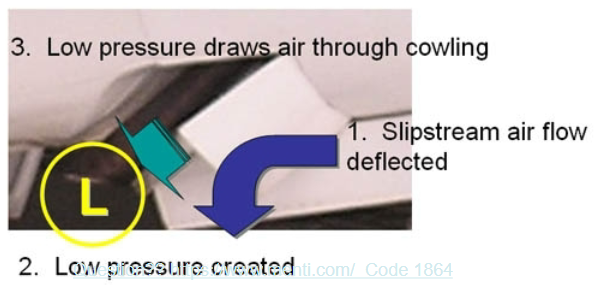
How else are engines air cooled?
Cowl flaps
Manual or automatic
Creates low pressure which draws air through the cowling
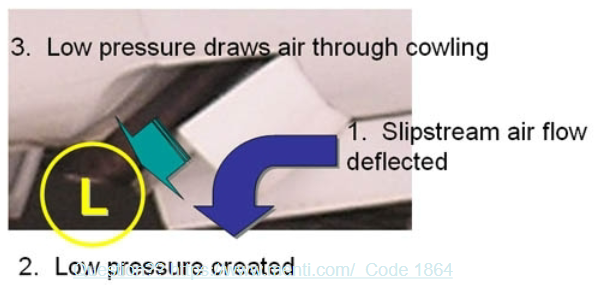
The majority of cooling is still tied to what?
Exhaust gasses venting out correctly